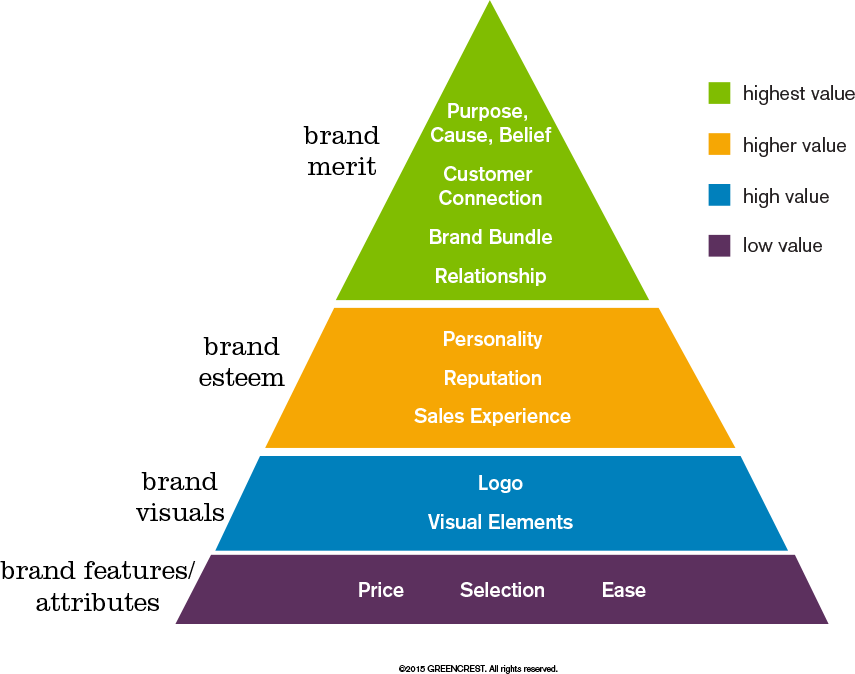The Brand Value Pyramid is a tool for CEOs to visualize company brand value. It illustrates some of the most common brand assets. To assess your company’s brand value, start at the bottom of the pyramid and continue upward, going from lowest to highest value.

Brand features/attributes
Most brands offer a suitable price point. Price point value is in the worth a customer places on it. Product offering is essential in most cases, but not all; it depends on the selections competitors are offering. You may present hundreds of SKUs or a limited number. Stellar customer service, friendly return policies and the use of the Internet to help facilitate a sales make doing business with your company easy in the eye of the customer.
However, customers expect this from brands they do business with. These offerings have low value when it comes to brand distinction and business value.
Brand visuals
Visual elements are the first opportunity to distinguish your brand from its competitors. Your logo, collateral materials and website, among other things, are mandatory for brand strength. But, don’t think for a minute that this is brand development. Until your brand’s unique distinction has been discovered, don’t start the visual identity process.
Brand esteem
To grow your brand valuation, define a sales experience that is second-to-none. What will make doing business with your company memorable? Most people will put price aside if the experience is enjoyable.
Reputation can be the vanguard of a good, highly valued brand. A valuable brand is known for doing good; treating customers, suppliers, associates and others right; as well as being honest, trustworthy and a good corporate citizen.
Every company has a culture — a personality. A grumpy old mechanic’s behavior may be acceptable because you know that under that crusty facade is a good heart, but that’s not a terrific brand asset. A brand that is quirky, brash or even savoir-faire can have brand strength, but only if its audience is attracted to or relates with its ways.
Brand merit
What does the relationship with your brand and its customers have to do with brand value? Everything. When customers enjoy or find value in your brand, they tell others. And that relationship is becoming increasingly digital with more customers than ever leaving reviews online. Online reviews impact more than 70 percent of purchasing decisions and more than 80 percent of people trust online reviews as much as personal recommendations.
Almost everything a company does that is unique can be trademarked — proprietary processes, unique approaches, specialized tools, and so on. When all of these trademarked processes and procedures (called Brand Points) are added to other proprietary practices, a brand bundle is created. It becomes a collection of assets or portfolio of services that competitors cannot provide.
Anywhere an audience encounters your brand in a place other than the point of sale is a connection. So how does your brand connect with its purchasers? Where are customers and prospects likely to encounter your business beyond your paid marketing efforts? There is great value in the connection your brand has with its customers.
A company’s purpose, cause and belief is as important as its brand offerings. Tom’s Shoes has a lot of competitors, but Tom’s is distinguished by its purpose. Why does your company exist? How are you changing your industry, your customers’ businesses and/or the world in which we live?
Ready to increase brand value? Contact the branding experts at GREENCREST to get started.

